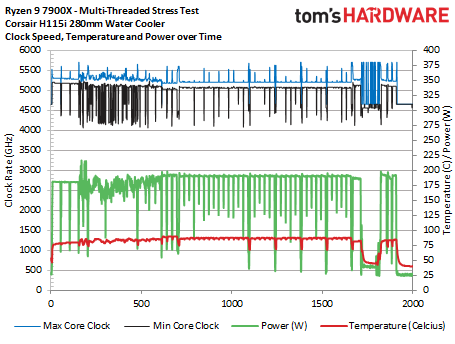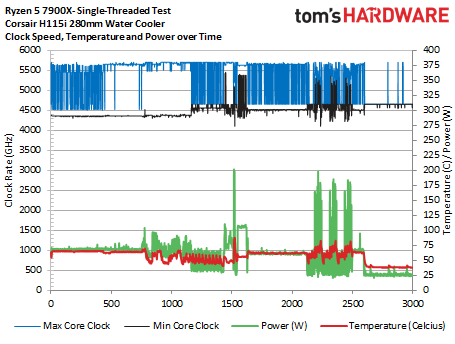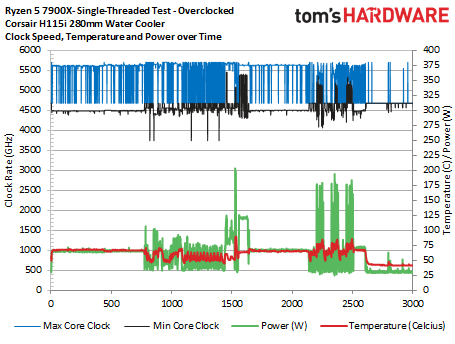Why you can trust Tom's Hardware
AMD Ryzen 9 7900X Boost Frequencies and Temperatures




As part of our normal test regimen, we tested performance in lightly-threaded work to record the peak boost speeds and thermals. We ran through our standard series of lightly-threaded tests (LAME, PCMark10, Geekbench, VRMark, and single-threaded Cinebench).
As with the previous-gen chips, some Ryzen 7000 chips can boost above their rated speeds if they have sufficient cooling and power. As always, the silicon lottery could apply. The Ryzen 9 7900X regularly peaked at 5.7 GHz, above the rated 5.6 GHz.
We also ran through a spate of standard heavily threaded applications (Cinebench, HandBrake, POV-Ray, Blender, AVX-heavy y-cruncher) to measure power and thermals. We used a Corsair H115i 280mm AIO with the fans cranked to 100% to keep the chip as cool as possible during this test run.
The 7950X hovered around 5.2 GHz through the most intense workloads when all cores were fully loaded. Peak power consumption reached 215W. The 7950X peaked at 90C during the test run but mostly hovered around 87C, which AMD assures us is expected behavior — the chip is designed to consume all available thermal headroom to provide faster performance. AMD assigns a 95C thermal threshold as the safe operating limit.
It’s often forgotten, but the Ryzen 5000 processors also operate in a similar fashion — 95C is a normal operating condition with stock coolers, which we wrote about in our original Ryzen 5000 reviews. By design, Intel’s latest chips also often run at 100C for extended periods. Both vendors are locked in intense competition for performance leadership, so we can expect this trend to continue.
Ryzen 9 7900X Benchmark Test Setup
We tested the Ryzen 7000 processors with an ASRock X670E Taichi motherboard. We tested all Intel configurations with DDR5 memory, but you can find performance data for DDR4 configurations in our CPU Benchmark hierarchy. We also tested with secure boot, virtualization support, and fTPM/PTT active to reflect a properly configured Windows 11 install.
Our overclocks were rather straightforward — we enabled the auto-overclocking Precision Boost Overdrive (PBO) feature with 'advanced motherboard' settings and adjusted the scalar setting to 10X. For our overclocked AMD configurations, we enabled the DDR5-6000 EXPO profile for the memory kit. This also automatically enables the AMD-recommended Auto setting for the fabric and a 1:1 ratio for the memory frequency and memory controller (Auto:1:1 is the recommended setting for memory overclocking with Ryzen 7000).
Get Tom's Hardware's best news and in-depth reviews, straight to your inbox.
| AMD Socket AM5 (X670E) | Ryzen 9 7950X, Ryzen 9 7900X, Ryzen 5 7600X |
| Row 1 - Cell 0 | ASRock X670E Taichi |
| Row 2 - Cell 0 | G.Skill Trident Z5 Neo DDR5-6000 - Stock: DDR5-5200 | OC/PBO: DDR5-6000 |
| Intel Socket 1700 DDR5 (Z690) | Core i9-12900K, i7-12700K, 15-12600K, i5-12400 |
| Row 4 - Cell 0 | MSI MEG Z690 Ace |
| Row 5 - Cell 0 | G.Skill Trident Z5 DDR5-6400 - Stock: DDR5-4400 | OC DDR5-6000 |
| AMD Socket AM4 (X570) | Ryzen 9 5950X, 5900X, 5700X, 5600X, 5800X3D |
| MSI MEG X570 Godlike | |
| Row 8 - Cell 0 | 2x 8GB Trident Z Royal DDR4-3600 - Stock: DDR4-3200 | OC/PBO: DDR4-3800 |
| All Systems | Gigabyte GeForce RTX 3090 Eagle - Gaming and ProViz applications |
| Row 10 - Cell 0 | Nvidia GeForce RTX 2080 Ti FE - Application tests |
| 2TB Sabrent Rocket 4 Plus, Silverstone ST1100-TI, Open Benchtable, Arctic MX-4 TIM, Windows 11 Pro | |
| Cooling | Corsair H115i, Custom loop |
| Overclocking note | All configurations with overclocked memory also have tuned core frequencies and/or lifted power limits. |
- MORE: AMD vs Intel
- MORE: Zen 4 Ryzen 7000 All We Know
- MORE: Raptor Lake All We Know
Current page: Boost Frequencies, Temperatures, Test Setup, AMD Ryzen 9 7900X
Prev Page Power Consumption, Efficiency, AMD Ryzen 9 7900X Next Page Gaming Benchmarks AMD Ryzen 9 7900X
Paul Alcorn is the Editor-in-Chief for Tom's Hardware US. He also writes news and reviews on CPUs, storage, and enterprise hardware.
-
chalabam The charts are hard to read. The fonts are too small, and the lines and dashes are very difficult to tell apart.Reply -
ddcservices Yet more nonsense in a supposedly unbiased review. Motherboards aren't really all that much more expensive than what came out for previous generations, outside of the boards that have far too many features or just add things that will cost a lot. PCI Express 5.0 support for example...a single PCIe 5.0 M.2 slot would be normal, and you will get it from all of the AM5 motherboards. Add a x16 slot with PCIe 5.0, and that adds to the prices.Reply
So, beyond this, boards like the Asus x670e Hero for $700...three M.2 slots with PCIe 5.0 speeds, the number of ports, this and that...yep, excessive, but the number of PCIe 5.0 slots are going to do that, along with Asus just charging a lot. The ASRock boards are NOT overpriced, and many of the other motherboards aren't overpriced really. So, no reason to complain about prices.
DDR5...$70 more than good DDR4 memory, compare the price of DDR4-3600 to DDR5-6000, yea, a bit of a price premium for DDR5, but it's new, and DDR5 prices are NOT really horrible. So, "pricing problem" seems to be more about an Intel bias, because other than, "it's new and hasn't been discounted". The pure gaming performance people will be happy with older AM4 for this generation and the Ryzen 7 5800X3D, but for those who do more than play games, honestly, motherboard+CPU+RAM all at the same time, CPU prices are NOT at a premium compared to previous generations, motherboards are generally at a comparable price, outside of a lack of cheap/low end boards that have no features, and B650 will cover that for the most part. RAM, don't compare DDR4-3000 to DDR5-6000 for price, because that's not a fair comparison. As I said, G.skill Trident Z5 Neo 6000CL30 vs. DDR4-3600CL14, what's the real price difference? Not really enough to complain about.
I may be biased, but not pointing out how Intel boards with similar features and on DDR5(not the cheaper DDR4 versions) are only cheaper because Intel is willing to give away chipsets at this point. -
TechieTwo According to reviews from those building AM5 systems the performance and value is fine from those not buying the extortion model mobos.Reply -
PlaneInTheSky ReplyYet more nonsense in a supposedly unbiased review. Motherboards aren't really all that much more expensive than what came out for previous generations
uhm, yes they are
The motherboards are a lot more expensive in nominal terms. Add in the depreciation of many currencies, and these AMD motherboards are extremely expensive. Add in the cost of DDR5.
The result is an outrageously expensive Zen 4 platform that doesn't even perform that well in games.
Zen 4 is going to need a massive price cut when Raptor lake arrives in a few days. Price / performance, Zen 4 is a disaster. The review is spot on. -
PlaneInTheSky ReplyDDR5 prices are NOT really horrible
Yes they are. Regardless, you have to buy new memory. It's not just about how much more DDR5 costs compared to DDR4, it's about needing to throw away DDR4 because AMD had the bright idea that dropping DDR4 compatbility was a smart move. This foolish decision is going to cost them a lot in sales. -
fybyfyby Reply
I agree with some of your statements. I bought new platform and it was worth it. But if I compare prices, DDR5 6000 EXPO costs nearly double the DDR4. Motherboard - ASUS B650 - E costs 9500 CZK and AM4 version (B550 - E) cost me 6500 CZK - but I didnt buy it at the start of the chipset. It was during the chipset lifetime. anyway, its more expensive. It may be due to PCIex5 added cost, I dont know. Also, DDR5 are new. Every gen, new DDR memories are "expensive".ddcservices said:Yet more nonsense in a supposedly unbiased review. Motherboards aren't really all that much more expensive than what came out for previous generations, outside of the boards that have far too many features or just add things that will cost a lot. PCI Express 5.0 support for example...a single PCIe 5.0 M.2 slot would be normal, and you will get it from all of the AM5 motherboards. Add a x16 slot with PCIe 5.0, and that adds to the prices.
So, beyond this, boards like the Asus x670e Hero for $700...three M.2 slots with PCIe 5.0 speeds, the number of ports, this and that...yep, excessive, but the number of PCIe 5.0 slots are going to do that, along with Asus just charging a lot. The ASRock boards are NOT overpriced, and many of the other motherboards aren't overpriced really. So, no reason to complain about prices.
DDR5...$70 more than good DDR4 memory, compare the price of DDR4-3600 to DDR5-6000, yea, a bit of a price premium for DDR5, but it's new, and DDR5 prices are NOT really horrible. So, "pricing problem" seems to be more about an Intel bias, because other than, "it's new and hasn't been discounted". The pure gaming performance people will be happy with older AM4 for this generation and the Ryzen 7 5800X3D, but for those who do more than play games, honestly, motherboard+CPU+RAM all at the same time, CPU prices are NOT at a premium compared to previous generations, motherboards are generally at a comparable price, outside of a lack of cheap/low end boards that have no features, and B650 will cover that for the most part. RAM, don't compare DDR4-3000 to DDR5-6000 for price, because that's not a fair comparison. As I said, G.skill Trident Z5 Neo 6000CL30 vs. DDR4-3600CL14, what's the real price difference? Not really enough to complain about.
I may be biased, but not pointing out how Intel boards with similar features and on DDR5(not the cheaper DDR4 versions) are only cheaper because Intel is willing to give away chipsets at this point.
So nothing to whine about. CPUs are great and if for someone AM5 is expensive, he or she can buy AM4 and it will last several years without a problem. -
somebassplayer The "pricing problem" is early adopter tax. People who want to be the first on their block to get onto 7xxxx series should expect to pay high(er) prices. The rest of us will wait until prices come down beforeReply
upgrading. -
ikernelpro4 Reply
I don't know about you but AM4 compatibility would've been clever to at least get more people / "early adopters".somebassplayer said:The "pricing problem" is early adopter tax. People who want to be the first on their block to get onto 7xxxx series should expect to pay high(er) prices. The rest of us will wait until prices come down before
upgrading.
100%. A lot of folks bought fast, perhaps even premium, DDR4 RAM in the past year or two, especially during the crazy-price pandemic.PlaneInTheSky said:Yes they are. Regardless, you have to buy new memory. It's not just about how much more DDR5 costs compared to DDR4, it's about needing to throw away DDR4 because AMD had the bright idea that dropping DDR4 compatbility was a smart move. This foolish decision is going to cost them a lot in sales.
I bought DDR4 3200 RAM and I do not plan to upgrade any time soon regardless what chip manufacturers present.
AMD simply bet on the wrong horse.
This is not a new platform that people who want to build complete new systems will fall onto, the price is not allowing that.
DDR5 is fast but you know what's also BLAZING fast? DDR4. Especially +3200 MHz. This is not a noticeble, jump like you PC unfreezes or suddenly memory intensive operations run like a night-day difference.
We have reached a point where "old" aka current hardware is so fast, that even many(!) years from now, they'll be fast and viable enough to substain.
This is not a jump from 5MB of DDR2 RAM to 16GB DDR4, this isn't a completely new platform. There's no incentive. -
Pyrostemplar ReplyPlaneInTheSky said:uhm, yes they are
The motherboards are a lot more expensive in nominal terms. Add in the depreciation of many currencies, and these AMD motherboards are extremely expensive. Add in the cost of DDR5.
The result is an outrageously expensive Zen 4 platform that doesn't even perform that well in games.
Zen 4 is going to need a massive price cut when Raptor lake arrives in a few days. Price / performance, Zen 4 is a disaster. The review is spot on.
No, it is a rather poor review, as it bases most (if not all) of its conclusion on the price of other components. In itself it wouldn't unreasonable if there was anything structurally definitive about the price of those said components: e.g. 4 channel server class motherboards. But no, AM5 mobos and DDR5 are the mainstream solutions going forward, so this review - and its conclusion - will age really badly.
AM5 X670E motherboards are already available under 300USD, and DDR5 is dropping price by the day. They won't go under DDR4 solutions pricing, but with inflation as it is, that is not really surprising, is it?
Zen 4 itself doesn't need a price cut unless Raptor outperforms its price/performance. If it does, then price cuts will be forthcoming - all the better for me :) -
cirdecus This is really not a good review. You don't knock off two stars for a product that is an excellent performer, priced well and uses the latest platform and technology. If you're upset that DD5 and AM5 costs a lot of money, that's a completely different article.Reply
Also, every new technology has come with a cost premium. Right now, you're intersecting a new socket, with new RAM technology and new PCI 5.0 tech all into one upgrade cycle. I don't care whether you go with an Intel platform or AMD platform, you're paying a lot for DD5, regardless. If you downgrade to DDR4, great, you can go with intel.
Complaining that DDR 5200 (6000 is actually what AMD recommends) is only supported by one channel and filling out the banks with 4 sticks drops the speed, is a relatively decent complaint. However, it's half a star at best. You're not going to win an argument that people need more than 64GB of highspeed memory in a system like this. If you need more, then this isn't the right platform. Users should be steered towards AMD's HEDT Thread-rippers. Mainstream processors simply don't need more than 64GB of memory. That's the equivalent of knocking an automobile manufacturer for not offering a 15000lbs towing capacity for their mid-sized trucks.